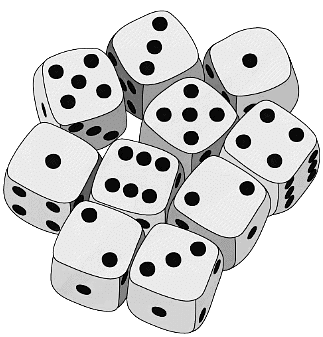Grade 10 Exam > Grade 10 Notes > Physics for Grade 10 > Random Nature of Radioactive Decay
Random Nature of Radioactive Decay | Physics for Grade 10 PDF Download
Introduction
- It cannot be predicted when a particular unstable nucleus will decay
- This is because radioactive decay is a random process, this means that:
- There is an equal probability of any nucleus decaying
- It cannot be known which particular nucleus will decay next
- It cannot be known at what time a particular nucleus will decay
- The rate of decay is unaffected by the surrounding conditions
- It is only possible to estimate the probability of a nuclei decaying in a given time period
- For example, a researcher might take some readings of background radiation
- If the researcher reset the counter to zero, waited one minute and then took the count reading and repeated the procedure, they might obtain results such as:
32 11 25 16 28 - The readings don't appear to follow a particular trend
- This happens because of the randomness of radioactive decay
Dice Analogy
- An analogy is a way of understanding an idea by using a different but similar situation
- Rolling dice is a good analogy of radioactive decay because it is similar to the random nature of radioactive decay
 A dice roll is a random process because you don't know when you will roll a particular value. However, you can determine the probability of a particular result
A dice roll is a random process because you don't know when you will roll a particular value. However, you can determine the probability of a particular result - Imagine someone rolling a dice and trying to get a ‘6’
- Each time they roll, they do not know what the result will be
- But they know there is a 1/6 probability that it will be a 6
- If they were to roll the dice 1000 times, it would be very likely that they would roll a 6 at least once
- The random nature of radioactive decay can be demonstrated by observing the count rate of a Geiger-Muller (GM) tube
- When a GM tube is placed near a radioactive source, the counts are found to be irregular and cannot be predicted
- Each count represents a decay of an unstable nucleus
- These fluctuations in count rate on the GM tube provide evidence for the randomness of radioactive decay
 The variation of count rate over time of a sample radioactive gas. The fluctuations show the randomness of radioactive decay
The variation of count rate over time of a sample radioactive gas. The fluctuations show the randomness of radioactive decay
The document Random Nature of Radioactive Decay | Physics for Grade 10 is a part of the Grade 10 Course Physics for Grade 10.
All you need of Grade 10 at this link: Grade 10
|
122 videos|150 docs|40 tests
|
Related Searches















